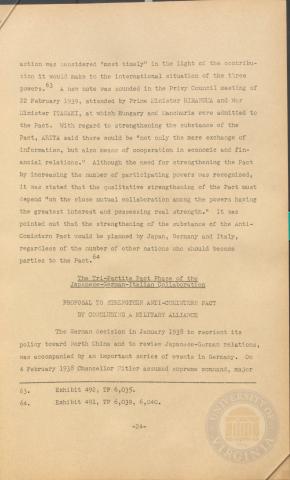
Page 24
| Parent | Japanese - German - Italian Collaboration |
|---|---|
| Date | |
| Language | English |
| Collection | Tavenner Papers & IMTFE Official Records |
| Box | Box 14 |
| Folder | Japan, Germany, Italy Collaboration and Introduction |
| Repository | University of Virginia Law Library |
action was considered "most timely" in the light of the contribu¬tion it would make to the international situation of the three powers.^ A new note was sounded in the Privy Council meeting of 22 February 1939, attended by Prime Minister HIRANUilA and War Liinister ITAGAKI, at which Hungary and Manchuria were admitted to the Pact. With regard to strengthening the substance of the Pact, ABITA said there would be "not only the mere exchange of •information, but also means of cooperation in economic and fin¬ancial relations." Although the need for strengthening the Pact by increasing the number of participating powers was recognized, it was stated that the qualitative strengthening of the Pact must depend "oh the close mutual collaboration among the powers haying the greatest interest and possessing real strength." It was pointed out that the strengthening of the substance of the Anti- Comintern Pact would be planned by Japan, Germany and Italy,
regardless of the number of other nations who should become
64
parties to the Pact.
The Tri-Partite Pact Phase of the Japanese-German-Italian Collaboration
PROPOSAL TO STRENGTHEN ANTI-COMINTERN PACT BY CONCLUDING .A MILITARY ALLIANCE
The German decision in January 1938 to reorient its policy toward North China and to review Japanese-Gorman relations, was accompanied by an important series of events in Germany. On 4 February 193S Chancellor Hitler assumed supreme command, major
63.Exhibit 492, TP 6,035.
64.Exhibit 491, TP 6,039, 6,040.
